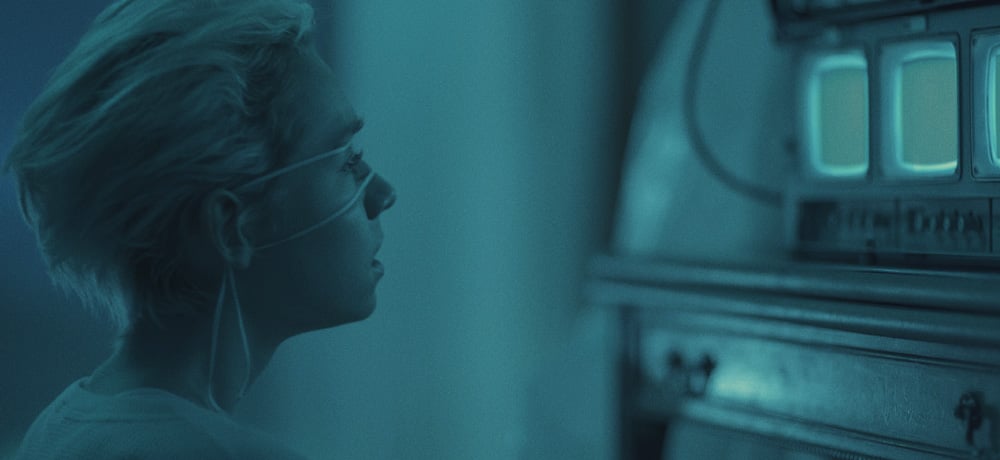


With Come True, writer/director Anthony Scott Burns has crafted a neon-soaked descent into the depths of the human mind that conjures up some very Cronenbergian feelings, but what Burns has created here is distinctive enough to firmly stand upon its own two feet. Featuring a stunning lead performance Julia Sarah Stone, Come True is a beautiful yet truly frightening examination of the power of dreams that features some of the most evocative dreamscape imagery this writer has witnessed since The Cell. Simply put – Come True is the kind of challenging and absorbing genre fare that will always catch my eye.
When we meet high schooler Sarah (the aforementioned Stone), she’s tucked away in a sleeping bag on a park slide, trying to catch some z’s. It’s obvious from the get-go that Sarah is struggling; after she wakes up breathlessly in the park, she heads home and waits for her mom to leave so she can sneak in, take a shower and get herself off to school. While in class, Sarah continually struggles to stay awake, and after she decides to sign up for a sleep study program, we learn what’s really at the heart of her problems: she’s suffering from horrifically debilitating nightmares and she’s desperate for some answers. At first everything goes along swimmingly during the study, but once Sarah confronts Jeremy (Landon Liboiron), one of the grad students running the study, over some unexpected side effects that have began to consume her life, she begins to realize that there’s more going on with her nightmares than she could have ever expected.
A truly engrossing horror/sci-fi hybrid, Come True is bound to bring up a lot of Cronenberg comparisons, which I get especially with its technology-driven approach to the mysteries of the mind. But for me, I felt like a lot of the energy on display here was reminiscent of what we saw out of the original Nightmare on Elm Street, not to say that Come True apes Wes Craven’s seminal film in anyway. But the innovative way that Burns approaches the conceptualization of dreams and nightmares felt like something we really haven’t seen before in a genre movie, which is no easy feat, and I have to admit I was absolutely enthralled from start to finish.
Come True’s blue-tinged visual palette does a brilliant job of lulling viewers into a false sense of security, and the hypnotic camera stylings from Burns (who also acts as the film’s cinematographer, which is pretty dang admirable in itself) really lends itself to the film’s dreamy narrative. As mentioned Stone is absolutely phenomenal in Come True, and compelling portrayal of a young woman on the brink is completely fascinating and heartbreaking as well. She’s a total revelation here and I hope to see her in more stuff in the future.
That being said, I’m still not sure about Come True’s banger of a finale. It’s a totally out-of-nowhere reveal that I’m still not quite sure wholly works with the rest of the film. I do appreciate that it left me with a lot of food for thought in the end though, and despite it not totally landing with me, Burns’ bold decision to take his story in this direction makes this writer eager to revisit Come True again in the future to see if it works better in retrospect. It’s definitely not enough to derail the movie whatsoever, but I suspect that it’s going to be a make-or-break moment for a lot of fans.
As a whole, Burns has created something special with Come True – a horror experience that’s both heady and emotional, and confidently conveys a palpable sense of dread every time poor Sarah closes her eyes, because you know terrible things await her, and us, as viewers. I always enjoy movies that challenge me a bit, and Come True does a fantastic job of pushing boundaries in ways I could have never anticipated.
Movie Score: 4/5